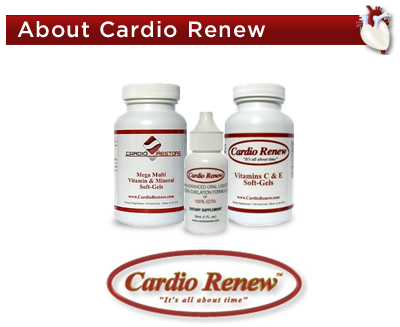Newsletter > September 2009 Vol. 1 Issue 4
Greetings!
As the health care debate continues on, it demonstrates that on whatever side of the issue that you fall, we are all passionate about our health and our health care options and choices. While our products exist outside of the realm of the main issues addressed in the health care reform debate, we are nonetheless watching it with interest, as one way or another, we all have a vested interest.
We at Cardio Renew are thankful that our customers do not limit their options simply to their selected health plans. In so doing, you discover a wide range of health options that are available to you, to treat a multitude of conditions, which in the end gives you a more active voice with regards to choice and your well-being. We hope you have an active relationship with your Doctor; one where your voice matters. We hope that you and your Doctor helped you to come to the decsion that Cardio Renew was the right choice and the best choice for you.
Wishing You Good Health and Vitality,

P.S. As always, we value your feedback, so please feel free to send any questions or comments to: newsletter@cardiorenew.com
-----------------------------------------------------------------------------------------------------------------------------

Mercury Found in All Fish Caught in U.S.-Tested Streams
Last month we reported that a heart healthy diet included two servings of fish per week, which was compiled using governmentally sponsored agency recommendations.
Within a week of our sighted recommendations, a government test of fish pulled from nearly 300 streams in the USA found every one of them contaminated with some level of mercury. The U.S. Geological Survey's research marks its most comprehensive examination of mercury contamination in stream fish.
The study found that 27% of the fish had mercury levels high enough to exceed what the Environmental Protection Agency considers safe for the average fish eater, those who eat fish twice a week. But the findings in wild-caught fish (not from fisheries, lakes or oceans for the purposes of this study, though lake and ocean fish have been found to contain mercury, as well) underscore how widespread mercury contamination in the nation's waterways has become. Previous research has found levels of concern in ocean and lake fish.
"This science sends a clear message that our country must continue to confront pollution, restore our nation's waterways and protect the public from potential health dangers," Interior Secretary Ken Salazar said in a statement.
Mercury is a neurotoxin especially dangerous to neurological development in infants and fetuses. Most mercury in water comes from particles from the atmosphere, the EPA says, fed largely by coal-fired power plants, trash burning and concrete plants nationally and internationally, the EPA says.
The USGS study examined mercury in 291 U.S. streams from 1998 to 2005. One surprising fact was that mercury levels were lower in streams in urban areas and higher in coastal plain streams fed by wetlands and forests, especially in North and South Carolina, Georgia, Florida and Louisiana. Those areas are biologically rich in the microbes that transform inorganic mercury in the atmosphere into the dangerous organic form called methyl mercury, says the USGS's Barbara Scudder, lead author on the paper.
The highest mercury levels were found in largemouth, smallmouth and spotted bass. The lowest were found in brown, rainbow-cutthroat trout and channel catfish. Though the EPA emphasizes that fish are an important part of a healthful diet, some contaminated species, especially from lakes and streams, may be unsuitable for women of childbearing age and children.
David Martosko of the Center for Consumer Freedom said in a statement, "Study after study has shown that the known health advantages from eating seafood far outweigh any hypothetical health risk."
Gavin Gibbons of the National Fisheries Institute cautioned: "It's important that consumers know that this does not relate to the everyday seafood that they find in restaurants or supermarkets. This is only recreational fish; this is not fish caught in the ocean or raised via aquaculture."
Forty-eight states have fish consumption advisories in place for certain species. A full list of such warnings is available at: www.epa.gov/waterscience/fish/advisories
This effects our message in two ways:
If you have sensitivity to heavy metal toxins, or if you have blockages that could be attributed, in part, to heavy metal toxins, then in either case you should visit Cardio Renew to learn more about cleasing your viens and arteries of heavy metals like mercury. At the same time remember that fish can be and should continue to be part of a heart healthy diet.

Cardio Renew Inc. is a family owned and operated company located in Minnesota. Cardio Renew was developed to offer you safe, effective and economical oral liquid EDTA chelation programs. Our #1 goal is to provide you quality products at an affordable price, while supplying the great customer service that you need and deserve.Here are a few items that we feel are important to the success of your oral chelation program:
- Quality Product-We purchase our products in liquid form and have our formulas blended, bottled, labeled and tamper-evident sealed at a professional manufacturing facility. This ensures you receive consistent, high quality products that provide safe and effective chelation therapies.
- Customer Service-Our goal is to answer e-mails, return phone calls and ship orders within 1 business day. Most times within a few hours or less.
- Best Value-Because Cardio Renew is a family based business, we keep our overhead and operating costs at a minimum. We do not promote sales, discounts or specials. We offer the best price to everyone, all year.
- No Multi-Level Marketing-We know that this not only raises the cost of products, but also takes away from the quality of customer service that you receive. We believe in helping our customers, not just making a sale.
- Honesty-We will always be truthful with our customers. We don't believe in scare tactics or deceptive marketing practices. We are an honest company, that takes pride in selling quality products, at an affordable price.
We believe in our products and programs and sincerely care about our customers. We truly feel that Cardio Renew can improve your health and therefore the quality of your life.
Interpreting Food Label Claims
It can be confusing when the goal is to eat healthy, yet when we read the food labels, we sometimes ask ourselves "What does all the jargon mean?" Here are the main label claims used on food packages--and what they mean:
- Saturated Fat
- Saturated fat free: Less than 1/2 gram saturated fat in a serving; levels of trans fatty acids must be not more than 1 percent of total fat.
- Low saturated fat: 1 gram saturated fat or less in a serving and 15 percent or less of calories from saturated fat. For a meal or main dish (like a frozen dinner): 1 gram saturated fat or less in 100 grams of food and less than 10 percent of calories from saturated fat.
- Cholesterol
- Cholesterol free: Less than 2 milligrams (mg) cholesterol in a serving; saturated fat content must be 2 grams or less in a serving.
- Low cholesterol: 20 mg cholesterol or less in a serving; saturated fat content must be 2 grams or less in a serving. For a meal or main dish: 20 mg cholesterol or less in 100 grams of food, with saturated fat content less than 2 grams in 100 grams of food.
- Fat
- Fat free: Less than 1/2 gram fat in a serving.
- Low fat: 3 grams total fat or less in a serving. For a meal or main dish: 3 grams total fat or less in 100 grams of food and not more than 30 percent calories from fat.
- Percent fat free--A food with this claim must also meet the low fat claim.
- Calories
- Calorie free: Less than 5 calories in a serving.
- Low calorie: 40 calories or less in a serving.
- Sodium
- Sodium free: Less than 5 mg sodium in a serving.
- Low sodium: 140 mg sodium or less in a serving. For a meal or main dish: 140 mg sodium or less in 100 grams of food.
- Very low sodium: 35 mg sodium or less in a serving.
- Words that mean the same thing as Free: "no," "zero," "without," "trivial source of," "negligible source of," and "dietary insignificant source of."
- Words that mean the same thing as Low: "contains a small amount of" and "low source of."
- Light
- A product has been changed to have half the fat or one-third fewer calories than the regular product; or the sodium in a low calorie, low fat food has been cut by 50 percent; or a meal or main dish is low fat or low calorie.
- "Light" also may be used to describe things like the color or texture of a food, as long as the label explains this: for example, "light brown sugar" or "light and fluffy."
- Reduced/Less/Lower/Fewer
- A food (like a lower-fat hot dog or a lower-sodium cracker) has at least 25 percent less of something like calories, fat, saturated fat, cholesterol, or sodium than the regular food or a similar food to which it is compared.
- Lean and Extra Lean
- Two terms--"lean" and "extra lean"--are used to describe the fat content of meat, poultry, fish, and shellfish.
- Lean
- Less than 10 grams fat, 4.5 grams or less of saturated fat, and less than 95 mg cholesterol in a serving.
- Extra lean
- Less than 5 grams fat, less than 2 grams saturated fat, and less than 95 mg cholesterol in a serving.

 ALL Packages and Prices
ALL Packages and Prices


